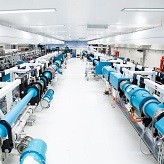A significant step in laser-fusion : reportage at LULI and CPHT

 At LULI, laser beams are amplified and used for nuclear fusion experiments, among other studies.
At LULI, laser beams are amplified and used for nuclear fusion experiments, among other studies.
On 18 August, the National Ignition Facility (NIF) at Lawrence Livermore National Laboratory in California announced that it had released 1.3 megajoules of energy in a fraction of a second during a nuclear fusion reaction. This amount corresponds to 70% of the energy contained in the 192 laser beams used to trigger the reaction. This result has not yet been published in an academical journal, but the press release states that this yield is 25 times greater than the previous record, also at NIF, published in the scientific literature. The scientists are thus approaching the 'ignition threshold' (100% yield). This is a historic result for this so-called 'inertial confinement' fusion method, the aims of which are to help simulate the operation of nuclear weapons, to understand fundamental astrophysical phenomena and, eventually, to produce electricity. But there is still a long way to go, both to reach this threshold and, above all, to hope to release more energy than was initially spent.
The France Culture programme "La Méthode scientifique" devoted an hour to this subject with Bernard Bigot, Director General of the ITER project (whose objective is to achieve fusion by another method, magnetic confinement) and Daniel Vanderhaegen, Director of the Programme simulation de la direction des applications militaires at CEA. On this occasion, a report was broadcast in the company of Patrick Audebert, director of the Laboratoire pour l'Utilisation des Lasers Intenses (Intense Lasers Laboratory LULI*) and Patrick Mora, researcher at the Centre for Theoretical Physics (CPHT*). They present the experimental facilities at École Polytechnique that also allow the study of inertial confinement fusion and the theoretical challenges that this represents.
>Listen to the programme here. The reportage starts around the 29th minute.
*LULI: a joint research unit CNRS, École Polytechnique - Institut Polytechnique de Paris, CEA, Sorbonne Université
*CPHT: a joint research unit CNRS, École Polytechnique - Institut Polytechnique de Paris
 Support l'X
Support l'X